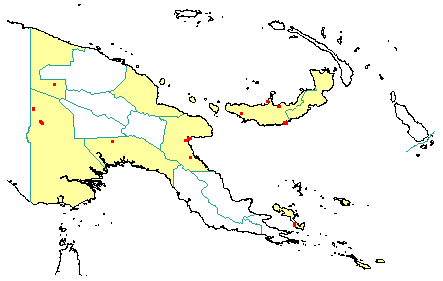
in PNGplants database
PNGTreesKey – Ceratopetalum tetrapterum Mattf. |
Barry Conn (NSW) & Kipiro Damas (LAE).
Guide to trees of Papua New Guinea
Copyright held by the authors, National Herbarium of New South Wales, and Papua New Guinea National Herbarium
Journal of the Arnold Arboretum Vol. 20: 432 (1939)
Family: Cunoniaceae
Dicotyledon
Timber Group: Minor hardwood
Field Characters: Large canopy tree (usually 20-30 m high) or Small sub-canopy tree (7-15 m high); Bole cylindrical (20-30 cm diam.); straight (bole 8-15 m long); buttresses buttresses absent; spines spines absent; aerial roots aerial roots absent; stilt roots stilt roots absent; Bark dark grey or brown, rough, scaly or flaky or fissured; Subrhytidome (under-bark) dark red; less than 25 mm thick, 10.0; bark blaze consisting of one layer; faintly to non-aromatic; outer blaze pink, red, or brown, markings absent, fibrous; inner blaze pink, red, or brown, markings absent, fibrous; bark exudate (sap) present, colourless (initially), not readily flowing (spotty), colour changing on exposure to air, to red, sticky; terminal buds not enclosed by leaves.
Indumentum: Complex hairs absent; stinging hairs absent; mature twig indumentum (hairs) absent.
Leaves: Leaves spaced along branches, opposite (in pairs, opposite one another on the branchlet), compound (a leaf made up from two or more leaflets) (with margin crenate and apex obtuse to shortly acuminate); petiole present, not winged, attached to base of leaf blade, not swollen; leaves with three leaflets (trifoliate); petiolule not swollen; leaves with a terminal leaflet (the number of leaflets odd - imparipinnate), broadest at or near middle, 7.0-20.0 cm, (2.5-) 3.0-8.0 cm, leaflets arranged from one point, symmetric, terminal developing leaflet buds straight; venation pinnate, secondary veins open, prominent or not prominent, but visible, intramarginal veins absent; leaves lower surface green, upper surface dark green, indumentum (hairs) absent; absent; domatia absent; stipules present, free, joined across twigs, not encircling the twig, leafy, not fringed, small, not persistent.
Flowers: Inflorescence terminal or axillary (distal leaf axes), flowers on a branched axis, cones absent; flowers bisexual, not stalked or stalked (shortly), flowers with many planes of symmetry, 4.0-5.0 mm long, diameter small (up to10 mm diam.) (c. 5 mm diameter); perianth present, with all sepals and/or petals (hence tepals) similar (sepals only), inner perianth white or pink (pale (sepals enlarging and turning red in fruit); 4, free; stamens 8, present, free of each other, free of the perianth; ovary partly inferior, carpels joined (when more than one), locules 1; styles free, 2 (partly persistent in fruit).
Fruits: Infrutescence arranged on branched axis, fruit 3.0-6.0 mm long, red or brown (covered with reddish hairs, sepals persistent and enlarged in fruit), not spiny, fleshy (leathery), simple, dehiscent, capsule (2-valved); seeds 1, to about 5 mm long (3-4 mm long), not winged, broad (as wide as long), seed 1-10 mm diam. (c. 3 mm diam.).
Distribution: Gulf, West Sepik, Madang, Morobe, Western, Papuan Islands & New Britain.
 | Botanical records in PNGplants database |
Notes: Notes Previously known as Ceratopetalum succirubrum C.T.White.